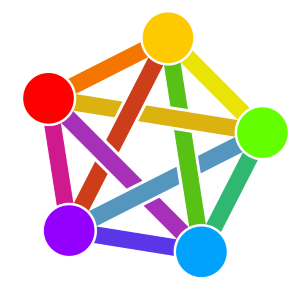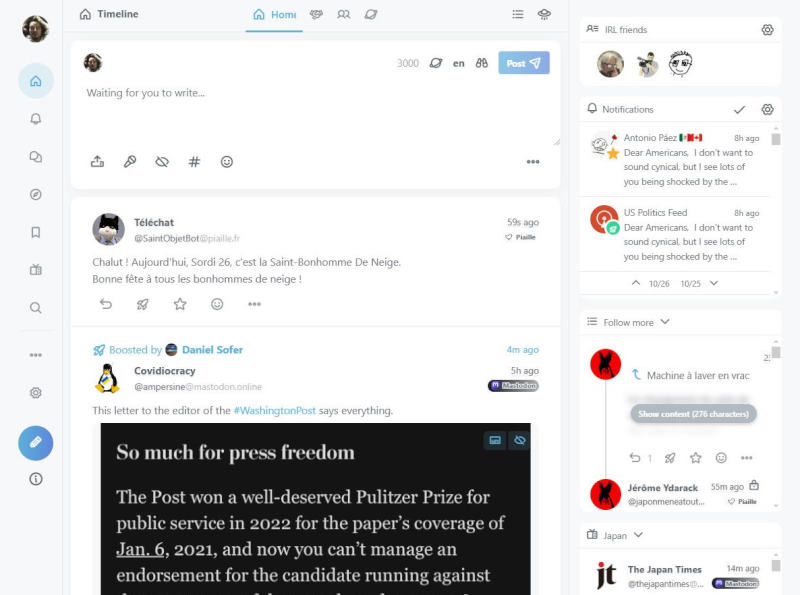What is the Fediverse?
As a new social media landscape has emerged over the past two years in the wake of Twitter’s demise, you may have heard the term “Fediverse” thrown around here and there. You may have heard it associated with Mastodon, but not only (Threads too, maybe?), but you may not really know what it is.
Let me explain, in plain English, because I’ve noticed that most of the content explaining the Fediverse is written by tech-oriented people, and while they know their stuff and are well-intentioned, they don’t always have the didactic skills to explain the thing in an accessible way to the general public (no offense, y’all).
Fediverse 101
What I’ve often heard people say is this:
“Isn’t the Fediverse just a fancy word for Mastodon?”
No, it’s not. And that’s often the biggest misconception about it, especially from Mastodon users themselves.
So the first thing to understand is that Mastodon and Fediverse are not interchangeable terms.
Mastodon is part of the Fediverse. The Fediverse is a larger thing that includes Mastodon.
Having said that, I admit that it is indeed difficult to talk about the Fediverse without talking about Mastodon, because until recently Mastodon was by far the largest platform on the Fediverse (about 70%.) However, things are changing, as we’ll soon see.
So, what is the Fediverse?
I said I was going to avoid technical terms, but there’s one we can’t ignore: ActivityPub.
ActivityPub is an Internet Protocol. An Internet Protocol is basically a thing that allows various elements of the Internet to be used.
You may not be aware of it, but you already know some of these protocols.
You know http/https which allows web browsers to access the internet and turn a bunch of data into a web page that humans can read and use.
You probably know smtp, pop, and imap, which allow emails to find their destination and travel through the net and back.
You may be familiar with RSS, which allows blogs and podcasts to be syndicated.
There are more.
What ActivityPub does is allow different services on the web that do different things to communicate with each other.
Here I need to introduce two keywords that you may be familiar with if you’re a Mastodon user (if you’re reading this, I assume you probably are): decentralization and federation.
Decentralization is the fact that Mastodon is not a single site like most other social media, but a (theoretical) infinite number of sites, usually called instances or servers (because that’s what they are).
Federation is the fact that all these sites and their users can seamlessly communicate with each other, even if their accounts are not on the same instance. It’s a bit like the way we can send email from our email address to anyone with an email address, even if the email providers (the part after the @) are not the same.
This federation is possible thanks to ActivityPub.
Now, the amazing thing is that what two Mastodon servers can do when they’re federated, other platforms can do with Mastodon, or with each other, without Mastodon being involved at all.
This web of platforms, sites, and services all communicating with each other thanks to ActivityPub is called, you guessed it, the Fediverse.

How to find and connect to accounts on other Fediverse platforms?
The same way you follow Mastodon accounts that are on another instance. You type or paste their handle into your search bar, and if the servers are federated, the account should appear and you should be able to follow it.
To compare to the usual suspects, imagine being able to follow Twitter accounts, Instagram accounts, Tumblr accounts, Reddit subs, or even entire websites from your Facebook account.
This is what Fediverse does.
When I explain this to Mastodon users, they usually ask me how to find such accounts, since all they see are other Mastodon accounts.
My usual response is: “Are you sure about that?”
Have you ever noticed “weird accounts” that seem to have no character limit? Some others just post pictures with little to no text? Or other kinds of oddities? Well, there’s a good chance that those accounts aren’t Mastodon accounts at all. And yet you follow and communicate with them.
“But they don’t look any different on my timeline except for these little tweaks, so what’s the point?”
They may not look different on your timeline, and that’s the “seamless” part of the communication. But you should know that they look different on their respective platforms.
To give you some examples, here are a few screenshots:
This is my Pixelfed profile

And this is my Firefish interface
(which is highly customizable, you can add and remove many types of widgets).
So? No difference from Mastodon? Are you sure?
What other platforms are there in the Fediverse?
There are quite a few, I don’t even know them all.
A big one is Misskey. It’s also a microblogging platform, and it’s older than Mastodon! If you’ve never heard of it, it’s because it’s Japanese. Because it can do a bunch of things that Mastodon can’t, and because it’s open source, some English-centric forks have sprung up in recent years, most notably Firefish, Iceshrimp, and Sharkey.
There are a few other microblogging platforms. One notable one is Akkoma.
But where it gets really interesting is that the Fediverse is not just about micro-blogging.
Actual blogging platforms are in the Fediverse or about to join it: WriteFreely, Ghost, and you may have heard of WordPress (more than 40% of the world’s websites). They’re all part of the Fediverse in one way or another. You can even follow this very blog on the Fediverse (see below)!
I mentioned Pixelfed above. It’s an Instagram replacement. Lemmy is a Reddit replacement (where you can follow people, but also topics). There’s Bookwyrm, a Goodreads replacement, etc.
You might think that’s a lot of “replacements” doing things that other platforms already do. And you’d be right.
While the Fediverse has been around for a while, it really started to gain traction and popularity beyond the purely open source and tech crowd in the last two years, when more and more people started to realize that leaving a big chunk, if not all, of their Internet lives on walled-garden platforms owned by not-so-stable billionaires was not the best of ideas.
So, yes, many people came up with the idea of recreating services we already use, but this time they’re open source and, as explained above, often decentralized and always federated. That way, they’re walled-garden-proof and can’t be owned by a single owner.
And if you ask me, I think that’s the Fediverse is the only sensible way for the Internet to move forward.
Now, let’s face it, the Fediverse is far from mainstream.
But I have hopes.
First of all, a bunch of new projects that are not “replacements of” are being developed and slowly appearing here and there.
But more importantly, some well-established platforms have joined the fray. I’ve already mentioned WordPress (the self-hosted platform needs a plugin to federate, but I don’t think the dot-com version does).
Flipboard and its 145 million monthly users are slowly but surely joining and federating.
Tumblr has also expressed a willingness to join, but as far as I know they’re running into technical hurdles – it’s much easier to create a new service that integrates ActivityPub from the ground up than to add it to something that already exists. However, WordPress and Flipboard show that it can be done.
And then there’s the case of Threads.
What about Threads?
Well, it’s complicated…
When Meta released Threads, they immediately announced that it would be part of the Fediverse.
Almost a year and a half later, it kind of is, but not really.
Threads accounts can be federated if the user wishes, but since it’s off by default and most users have no idea what it is, very few users have enabled it. Also, while Fediverse users can follow Threads accounts, the reverse is not currently possible.
Still, things are getting better (now Threads users can see replies they get from the Fediverse), but we’re still a long way from full federation. I assume that Meta will never allow account migration to another platform, for example.
And Bluesky?
Bluesky is not part of Fediverse. Unfortunately, it’s building its own version of the Fediverse, but it’s still in its infancy and there’s not much to say about it at the moment.
However, if you know people on Bluesky but don’t have an account there, or vice versa, if you’re a Bluesky user who’s intrigued by the Fediverse, you should know that there is a way to bridge Fediverse and Bluesky accounts.
It’s called Bridgy Fed, and I highly recommend you check it out and bridge your account(s). These walled gardens must come down!
In conclusion
I hope this short overview helps you understand what the Fediverse is and that it’s not just a synonym for Mastodon.
If you’re curious about other services, my advice would be to just try them out. Who knows, you might like one or two. And if you’re not as terminally online as I am and decide that having multiple accounts isn’t your thing, know that in most cases there’s a way to merge accounts, even from different platforms (not all do, so check before you put all your eggs in one basket – my advice is not to put all your eggs in one basket, though).
Enjoy and tell me what you tried and your impressions.
Follow me on the Fediverse
- Mastodon
- Firefish
- Pixelfed
- This blog itself! (copy and paste: @liminalweb in your Fediverse account search bar)
- (I have a few more accounts but these four are the ones where I’m active)
If you liked what you read, please share on your social media of choice (especially if it’s not on the Fediverse, we need to bring more people in) and also:
Discover more from liminal web
Subscribe to get the latest posts sent to your email.

